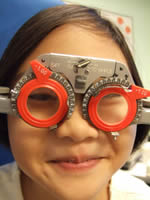

ACS Eye Specialist Centre
95G & 97G Jalan TKS 1,
Taman Kajang Sentral,
43000 Kajang,
Selangor, Malaysia.
Tel: 03-82116078
Waze or Google Map
Amblyopia (Lazy Eye)
What is meant by the term “Lazy Eye” or “ Amblyopia”?
This is a term used to describe an uncorrectable loss of vision in an eye that appears to be normal.
A child’s visual system is fully developed at approximately the age of 7 years old. Until this children are in a “plastic period” where they can adapt to visual problems by suppressing or blocking out the image. If caught early, the problem can often be corrected and the vision preserved. As the child grows older, it is more difficult to retrain the eye. The cut off period where the eye can still be trained, is found to be 7 years old. After this young age, the blur vision is permanent even with optical aids (spectacles, glasses) or surgery/laser (LASIK, LASEK, PRK). This results in a visual handicap, denying the child a choice in careers that require good vision.
Some causes of amblyopia include: strabismus (squint, crossed or turned eye), congenital cataracts, cloudy cornea, droopy eyelid, unequal vision and uncorrected nearsightedness (short sightedness), farsightedness (long sightness) or astigmatism. Amblyopia may occur in various degrees depending on the severity of the underlying problem. Some patients just experience a partial loss; others are only able to recognize motion.Why are we concerned if a child develops a lazy eye or amblyopia?
Patients with amblyopia lack binocular vision, or stereopsis – the ability to blend the images of both eyes together. Stereopsis is what allows us to appreciate depth. Without it, the ability to judge distance is impaired.
What would make us suspect a child has amblyopia?
The child may have poor vision in one or both eyes. Squinting or closing one eye while reading or watching television should be investigated. A child may also have a crossed or deviated eye. If you notice that your child habitually turns or tilts the head to look at objects there could be some problem with the vision.
How is amblyopia detected?
Children rarely complain of poor vision. As long as they can see clearly out of one eye, they may not realise that they have poor vision in the other eye. Routine examination is recommended to detect potential problems.
When amblyopia is suspected, the doctor will evaluate the following: vision, eye alignment, eye movements, and fusion (the brain’s ability to blend two images into a single image).The eye doctor will also check the anterior and posterior segments of the eye to look for abnormalities.What is the treatment for amblyopia?
The treatment for amblyopia depends on the underlying problem. If there is a refractive error, glasses will be prescribed to correct the vision. If one eye is weaker than the other , the stronger eye is temporarily patched a few hour per day to encourage the child to use the weaker eye and not suppress images from that eye. If there are cataracts or droopy eyelids these often require surgical intervention. Whatever the cause of amblyopia is, it is very important that intervention is implemented as early as possible before the child’s brain learns to permanently suppress or ignore the eye.